I am new to R and can't find an answer to this (seemingly) simple question. I have been searching for a couple of days, and did read a couple of papers and the help pages.
I have been able to plot one line (in red).

I want to plot another line fitted to the back dots. I expect the line to look like the black line in this image (by Křivan and Priyadarshi, 2015).

However, I have not been able to plot the line.
I have tried to fit the line using the following code, but nothing shows on the graph:
Values that I want to fit a line through:
Prey_isocline_x <- c(8.2, 7.15, 7.65, 10.6, 7.947368421, 5.35,
6, 8.2, 7.473684211, 1.5, 1.3, 0.95, 1.85,
1.15, 0.6, 2.7, 1.3, 0.25, 0.25, 6.263157895,
4, 0.3, 5.1, 4.15, 1.15, 1.6, 1.6, 1.55)
Prey_isocline_y <- c(0.45, 0.3, 0.2, 0.2, 0.105263158, 0.8, 0.5,
0.15, 0.052631579, 0.642857143, 1, 1, 1.15,
0.7, 0.55, 0.35, 0.8, 1.15, 1.55, 0.578947368,
0.5, 2.55, 0.15, 0.25, 0.45, 2.45, 2.45, 1.3)
Prey_isocline <- data.frame(Prey_isocline_x, Prey_isocline_y)
Predator_isocline_x <- c(0.25, 0.15, 0.3, 0.7, 0.25, 0.25, 0.05, 0.5, 0.45,
0.5, 0.5, 0.15, 0.6, 1.4, 0.85, 0.15, 0.15, 0.6)
Predator_isocline_y <- c(2.35, 2.9, 3.6, 3.6, 2.35, 4.45, 1.45, 1.7, 1.65,
1.7, 2.9, 1.8, 1.9, 2.35, 2.9, 2.8, 2.5, 3.05)
Predator_isocline <- data.frame(Predator_isocline_x, Predator_isocline_y)
First attempt to plot:
plot(Prey_isocline_x, Prey_isocline_y,
axes = F,
xlab= "",
ylab= "",
pch=1, col="black")
fit <- nls(Prey_isocline_y ~ SSlogis(Prey_isocline_x, Asym, xmid, scal),
data=Prey_isocline,
trace = TRUE)
summary(fit)
curve(predict(fit, newdata = data.frame(Prey_isocline_y=x)), add=TRUE)
Output first attempt:
> par(new=T)
> plot(Prey_isocline_x, Prey_isocline_y,
+ axes = F,
+ xlab= "",
+ ylab= "",
+ pch=1, col="black")
> fit <- nls(Prey_isocline_y ~ SSlogis(Prey_isocline_x, Asym, xmid, scal),
+ data=Prey_isocline,
+ trace = TRUE)
Error in nls(y ~ 1/(1 + exp((xmid - x)/scal)), data = xy, start = list(xmid = aux[1L], :
step factor 0.000488281 reduced below 'minFactor' of 0.000976562
> summary(fit)
Error in summary(fit) : object 'fit' not found
> curve(predict(fit, newdata = data.frame(Prey_isocline_y=x)), add=TRUE)
Error in predict(fit, newdata = data.frame(Prey_isocline_y = x)) :
object 'fit' not found
Second try:
model <- loess(formula=Prey_isocline_x~Prey_isocline_y,
data=Predator_isocline)
abline(model, col="black")
Second output:
> model <- loess(formula=Prey_isocline_x~Prey_isocline_y, data=Predator_isocline)
> abline(model, col="black")
Third attempt:
nls_fit <- nls(Prey_isocline_y ~ (b*Prey_isocline_x) - (b*Prey_isocline_x*Prey_isocline_x/K) -
(Predator_isocline_y*(Prey_isocline_x^k/(x^k+C^k)*(l*x/(1+l*h*x)))),
data = Prey_isocline,
start = list(b = 2.2,
e = 1.5,
K = 30,
k = 20,
l = 0.1,
h = 0.25,
C = 1,
m = 1.0))
lines(Prey_isocline_x, predict(nls_fit), col = "green")
Third output:
> nls_fit <- nls(Prey_isocline_y ~ (b*Prey_isocline_x) - (b*Prey_isocline_x*Prey_isocline_x/K) -
+ (Predator_isocline_y*(Prey_isocline_x^k/(x^k+C^k)*(l*x/(1+l*h*x)))),
+ data = Prey_isocline,
+ start = list(b = 2.2,
+ e = 1.5,
+ K = 30,
+ k = 20,
+ l = 0.1,
+ h = 0.25,
+ C = 1,
+ m = 1.0))
Error in nlsModel(formula, mf, start, wts) :
singular gradient matrix at initial parameter estimates
In addition: There were 30 warnings (use warnings() to see them)
> lines(Prey_isocline_x, predict(nls_fit), col = "green")
Error in predict(nls_fit) : object 'nls_fit' not found
Fourth try:
nls_fit <- nls(Prey_isocline_y ~ a + b * Prey_isocline_x^(-c), Prey_isocline,
start = list(a = 80, b = 20, c = 0.2))
lines(Prey_isocline_x, predict(nls_fit), col = "green")
Fourth output:
> nls_fit <- nls(Prey_isocline_y ~ a + b * Prey_isocline_x^(-c), Prey_isocline,
+ start = list(a = 80, b = 20, c = 0.2))
Error in nls(Prey_isocline_y ~ a + b * Prey_isocline_x^(-c), Prey_isocline, :
step factor 0.000488281 reduced below 'minFactor' of 0.000976562
> lines(Prey_isocline_x, predict(nls_fit), col = "green")
Error in predict(nls_fit) : object 'nls_fit' not found
I am completely lost and I hope someone can help me.


